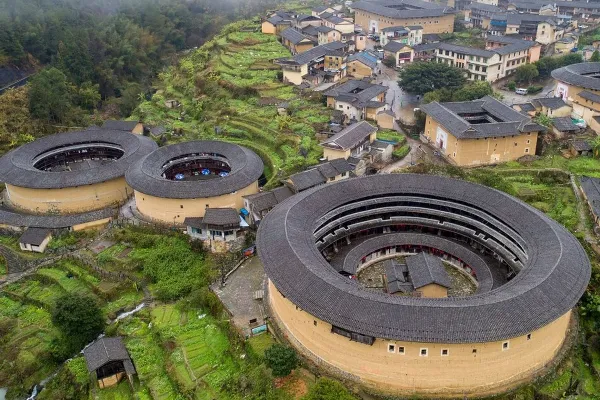
The Fujian Tulou (Nanjing) Scenic Area is located in Nanjing County, Zhangzhou City, Fujian Province. It is a national 5A-level tourist attraction and a UNESCO World Heritage Site. The area is famous for its unique Hakka earthen buildings, with the most iconic being the "Four Dishes and One Soup" Tianluokeng Tulou Cluster. There are over 15,000 tulou buildings in Nanjing, including more than 130 that are over a century old. The largest tulou has a diameter of 80 meters. The scenic area covers approximately 200 square kilometers and includes several sections such as Tianluokeng, Yunshuiyao, and Hekeng.
History and Culture
The Nanjing Tulou buildings are precious heritage of Hakka culture, dating back to the Song and Yuan Dynasties and flourishing during the Ming and Qing Dynasties. These unique circular structures were originally built by Hakka people for defense purposes, combining residential and defensive functions. Constructed with local materials like rammed earth, wood, and pebbles, they showcase the Hakka people's wisdom in harmonizing with nature.
More than architectural marvels, the tulou buildings reflect Hakka social structure. A single tulou typically houses dozens of families from the same clan, embodying the Hakka spirit of unity and mutual assistance. Equipped with communal facilities like ancestral halls and wells, each tulou forms a self-sufficient mini-society.
In 2008, Fujian Tulou was inscribed on the UNESCO World Heritage List. As an important component, Nanjing Tulou presents to the world the unique charm of traditional Chinese residential architecture. These centuries-old buildings still serve as homes for Hakka people today, preserving their ancient way of life.
Main Attractions
Tianluokeng Tulou Cluster
The Tianluokeng Tulou Cluster consists of five tulou buildings, nicknamed "Four Dishes and One Soup" due to their resemblance to a meal setup when viewed from above. It includes one square tulou (Buyunlou), three round tulou (Hechanglou, Zhenchanglou, and Ruiyunlou), and one oval tulou (Wenchanglou), built from the Kangxi period of the Qing Dynasty to the Republic of China era. Nestled against mountains with terraced fields, this picturesque cluster is a paradise for photography enthusiasts.
Yunshuiyao Ancient Town
Originally named Changjiao, Yunshuiyao was renamed after the movie "The Knot" was filmed here. The ancient town stretches along a stream, featuring thousand-year-old banyan trees and over a dozen well-preserved tulou buildings. Cobblestone paths, waterwheels, and ancient banyans create a serene rural landscape, perfect for experiencing Hakka slow living.
Yuchanglou
Also known as the "Leaning Tower of Tulou," Yuchanglou was built in the late Yuan and early Ming Dynasties, making it one of Nanjing's oldest surviving tulou. This five-story round building has noticeably tilted beams and pillars above the third floor (up to 15 degrees), yet has stood firm for centuries - a true architectural wonder.
Taxia Village
Taxia Village is renowned as the "Taiji Riverside Village," home to the Zhang clan. Built along an S-shaped stream, the village features over 40 tulou buildings and ancestral halls arranged in a taiji pattern. The Deyuan Ancestral Hall here is the best-preserved Zhang family temple in southern Fujian, with 23 stone flagpoles standing majestically before it.
Cuisine
Hakka Stuffed Tofu
A traditional Hakka delicacy where tofu is hollowed out, stuffed with minced meat, and pan-fried until golden. Crispy outside and tender inside, it perfectly combines bean and meat flavors, essential for Hakka hospitality.
Nanjing Salted Duck
Made with free-range local ducks, salted using traditional methods and then boiled. The meat is firm, flavorful, and moderately salty - a distinctive Nanjing specialty.
Taro Dumplings
Traditional Hakka snack with a wrapper made from taro and tapioca flour, filled with ingredients like mushrooms and minced pork before steaming. The chewy skin and savory filling carry a rich taro aroma.
Tulou Red Mushroom Soup
Prepared with wild red mushrooms native to Nanjing mountains, stewed with free-range chicken or pork ribs. The reddish soup is delicious and nutritious, a local tonic dish.
Ticket Information
The Nanjing Tulou Scenic Area has separate ticketing zones: Tianluokeng area ticket costs ¥90/person (including Tianluokeng, Yuchanglou, and Taxia Village); Yunshuiyao area ticket is ¥90/person. A combo ticket for both areas is ¥120/person. Discounts (50% off) are available for seniors over 60 and students, while children under 1.2m enter free. Opening hours are 8:00-18:00.
Suggested Itinerary
Recommended one-day tour: Visit Tianluokeng Tulou Cluster in the morning (panoramic view from observation deck → Buyunlou → Yuchanglou), have lunch and explore Taxia Village at noon; head to Yunshuiyao Ancient Town in the afternoon, stroll along cobblestone paths under ancient banyans, and visit Heguilou and Huaiyuanlou tulou buildings. With more time, consider staying overnight in Taxia or Yunshuiyao to experience Hakka homestays and the tranquil tulou nights.
Transportation
- Self-drive: From Xiamen via G76 Expressway to Nanjing exit, then about 1 hour on county roads to the scenic area
- Public transport: Direct tourist buses available from Xiamen Hubin South Bus Station to Nanjing Tulou
- Within scenic area: Shuttle buses connect major sites; walking or local motorcycle rentals are alternatives
Must-See Attractions
- Tianluokeng Tulou Cluster - Iconic "Four Dishes and One Soup" view
- Yuchanglou - Architectural marvel of the "Leaning Tower"
- Yunshuiyao Ancient Town - Poetic dwelling among ancient banyans and streams
- Taxia Village - Unique "Taiji Riverside" village layout
Travel Tips
- Best seasons are spring and autumn, avoiding rainy season and extreme heat
- Wear comfortable walking shoes as paths are mostly stone or dirt
- Bring sun protection and rain gear - mountain weather changes quickly
- Allocate sufficient time - at least 1-2 hours per attraction
- Try staying in a tulou homestay for authentic Hakka living experience
Important Notes
- Most tulou are residential - maintain quietness and respect local customs
- Avoid touching walls and artifacts to protect this World Heritage Site
- Drive cautiously on winding mountain roads if self-driving
- Purchase local products from authorized stores to avoid scams
- Some areas have weak signals - download offline maps in advance